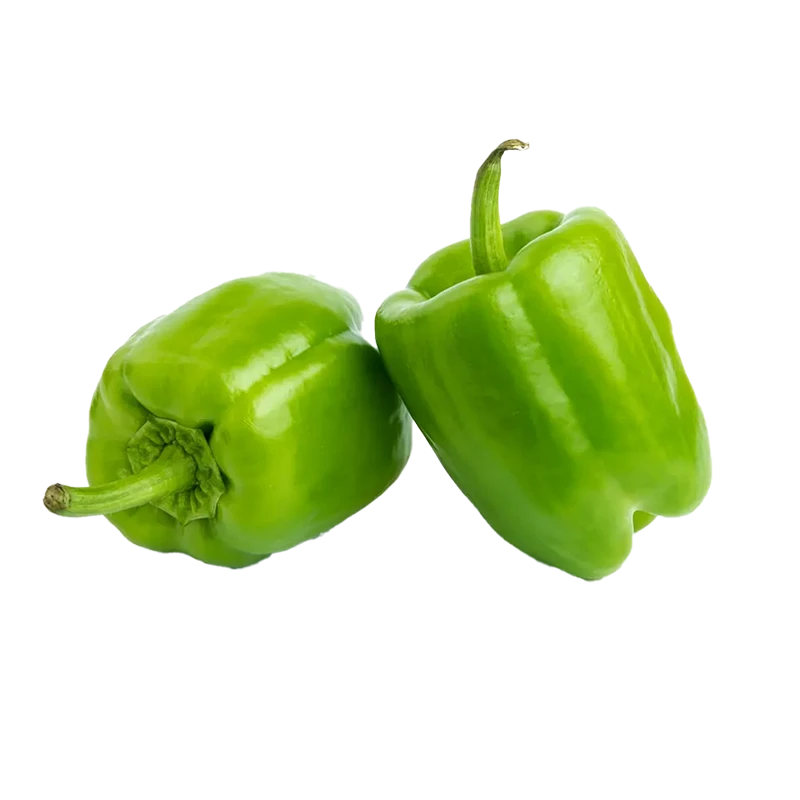Green Pepper — Nutrients, Health Benefits, And Shopping Tips

Written by Listonic Team
Last update on September 4, 2024
Nutrition facts
Nutrition facts
Amount per 100 g
Calories
🔥 20 kcal
| Nutrition per: 100 g | Value | % Daily Value* |
|---|---|---|
| Carbs | 5 g | 1.82% |
| Fiber | 2 g | 7.14% |
| Sugars | 2 g | 4% |
| Glycemic Index | 15 | - |
| Protein | 1 g | 2% |
| Sodium | 3 mg | 0.13% |
| Total Fat | 0 g | - |
*The % of Daily Value (DV) tells you how much a nutrient in a serving of food contributes to a daily diet. 2,000 calories a day is used for general nutrition advice.
20
🍏 Low-Calorie Foods
15
🟢 Low Glycemic Index
Did you know?
Health benefits
- Rich in vitamins and antioxidants such as Vitamin C, Vitamin A, and beta-carotene, which help protect the body from free radicals and support immune function.
- High in fiber, promoting digestive health, regular bowel movements, and a healthy gut microbiome.
- Low in calories, making them a nutritious option for weight management and overall health.
- Contains essential minerals such as potassium, which supports heart health and proper muscle function.
Health risks
- Potential for digestive discomfort such as gas or bloating when consumed in large quantities, particularly for individuals sensitive to high-fiber foods.
- Risk of pesticide residue on conventionally grown green peppers, which can pose health risks if not properly washed or sourced from organic suppliers.
- Potential for allergic reactions in some individuals sensitive to nightshade vegetables, causing symptoms like itching, swelling, or difficulty breathing.
- Potential nutrient loss if green peppers are overcooked, reducing levels of vitamins and antioxidants.
How to choose green pepper
Green peppers should have a vibrant, uniform green color and feel heavy for their size. The skin should be taut and glossy without any wrinkles. Press the skin gently; it should not indent, which suggests it is fresh and crisp.
Avoid green peppers that are soft or have sunken areas, which are signs of decay. Fresh green peppers should have a crisp texture and a slightly bitter flavor, perfect for cooking or eating raw in salads.

How to store green pepper
Green peppers should be kept in the refrigerator's crisper drawer. Store them in a plastic bag to maintain their freshness and crunch. Properly stored, green peppers can last up to two weeks.
Green peppers can become soft and lose their crunch if not stored properly. Avoid washing them before storing to prevent excess moisture. Keeping them cool and dry preserves their texture and flavor, making them ideal for salads and cooking.
✅ Extra Tip
How long does it last?
Green peppers can last for 1-2 weeks in the refrigerator. To maintain their freshness, store them in the crisper drawer. For longer storage, green peppers can be chopped and frozen, lasting up to 6-12 months.
What to do with leftovers?
Leftover green peppers can be used in a variety of savory dishes. Chop them and add to salads, sandwiches, or wraps for a fresh, crunchy bite, or mix them into a stir-fry with other vegetables and your choice of protein. Green peppers are also great in omelets, frittatas, or quiches, where they add color and flavor.
Use green peppers in a pasta dish with a tomato or cream sauce, or roast them with olive oil and herbs for a sweet, caramelized flavor. If you have a lot of green peppers, consider making a batch of stuffed peppers, filled with rice, meat, and cheese, then baked until tender. Green peppers can also be added to soups or stews for extra texture and flavor, or grilled and used as a topping for pizzas or burgers. For a quick snack, dip raw green pepper slices in hummus or your favorite dip.
👨⚕️️ Medical disclaimer
Discover products from other categories
Listonic Team
Fact-checked
Our editorial team checked this article to make sure it was accurate at the time of publishing it.
Get the top-rated shopping list app on your phone!







